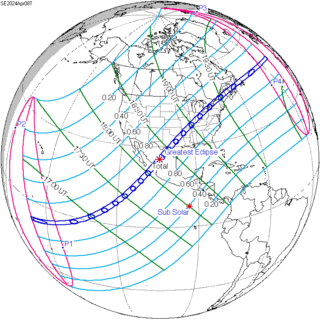
A | B | C | D | E | F | G | H | CH | I | J | K | L | M | N | O | P | Q | R | S | T | U | V | W | X | Y | Z | 0 | 1 | 2 | 3 | 4 | 5 | 6 | 7 | 8 | 9
| Solar eclipse of April 8, 2024 | |
|---|---|
 The solar eclipse during totality, seen from Dallas, Texas | |
| Type of eclipse | |
| Nature | Total |
| Gamma | 0.3431 |
| Magnitude | 1.0566 |
| Maximum eclipse | |
| Duration | 268 s (4 min 28 s) |
| Location | Nazas, Durango, Mexico |
| Coordinates | 25°18′N 104°06′W / 25.3°N 104.1°W |
| Max. width of band | 198 km (123 mi) |
| Times (UTC) | |
| (P1) Partial begin | 15:42:07 |
| (U1) Total begin | 16:38:44 |
| Greatest eclipse | 18:18:29 |
| (U4) Total end | 19:55:29 |
| (P4) Partial end | 20:52:14 |
| References | |
| Saros | 139 (30 of 71) |
| Catalog # (SE5000) | 9561 |
The solar eclipse of April 8, 2024, also known as the Great North American Eclipse,[1] was a total solar eclipse visible across a band covering parts of North America, from Mexico to Canada and crossing the contiguous United States. A solar eclipse occurs when the Moon passes between Earth and the Sun, thereby obscuring the Sun. A total solar eclipse occurs when the Moon's apparent diameter is larger than the Sun's, blocking all direct sunlight. Totality occurs only in a limited path across Earth's surface, with the partial solar eclipse visible over a larger surrounding region.
During this eclipse, the Moon's apparent diameter was 5.5 percent larger than average. With a magnitude of 1.0566, the eclipse's longest duration of totality was 4 minutes and 28 seconds near the Mexican town of Nazas, Durango.[2][3]
Totality was visible from 6 Mexican states, 15 U.S. states, and 6 Canadian provinces. [4] Approximately 44 million people lived in the path of totality, including 32 million in the United States, 6 million in Canada, and 6 million in Mexico. [5] [6] [7] The 10 largest cities in the path of totality accounted for a third of this population (5 of the 10 largest cities being in the United States, 3 in Mexico, and 2 in Canada).[8] Adding people who travelled to the path of totality, an estimated 50 million people experienced the total solar eclipse. [8] Meanwhile, about 652 million people experienced a partial solar eclipse.[5]
This eclipse was the first total solar eclipse visible from Canada since August 1, 2008, and from the provinces since February 26, 1979.[9][10] It was the first over Mexico since July 11, 1991.[11] It was also the first over the United States since August 21, 2017. This is the only solar eclipse in the 21st century with totality visible from all three countries.[12] The next total solar eclipse in the US will be on March 30, 2033, which will pass over Alaska. The next total eclipse in the contiguous United States of the US will be on August 23, 2044. The next total eclipse of similar width will take place on August 12, 2045, which will traverse coast-to-coast in a trajectory similar to the 2017 eclipse.
An annular eclipse on October 2, 2024, will be the final solar eclipse of the year. The path of annularity will cross over Chile and Argentina.
General path of shadow

The totality of the solar eclipse was visible in a strip beginning in the Pacific Ocean, the edge of which passed approximately 60 kilometers north of Penrhyn atoll,[13] 115 kilometers south of Starbuck Island, 275 kilometers north of Vostok Island, and 370 kilometers north of the Marquesas Islands. Later, the total solar eclipse was visible from North America, starting from the west coast of Mexico then ascending in a northeasterly direction through Mexico, the United States, and Canada, before ending in the Atlantic Ocean about 700 kilometers southwest of Ireland.[14]
Visibility in the Americas
Mexico
Totality first passed over the Revillagigedo Islands (a federal possession of Mexico and associated with Colima state) and Islas Marías of Nayarit. Upon reaching the continental mainland, totality passed through the states of Sinaloa (including Mazatlán), northern Nayarit, Durango (including the city of Durango and Gómez Palacio), extreme southeast Chihuahua, and Coahuila (including Torreón, Matamoros, Monclova, Sabinas, Ciudad Acuña, and Piedras Negras).[15][16][17] A partial eclipse was visible across the remainder of the country, including 79% coverage of the solar disc in Mexico City.[18] Torreón was the most populous Mexican city in the path of totality.
United States

In the United States, totality was visible through the states of Texas (including parts of San Antonio, Austin, Fort Worth, and all of Arlington, Dallas, Killeen, Temple, Texarkana, Tyler, Sulphur Springs, and Waco); Oklahoma (including Idabel and Broken Bow); Arkansas (including Morrilton/Petit Jean, Hot Springs, Searcy, Jonesboro, and Little Rock); Missouri (including Cape Girardeau and Poplar Bluff); Tennessee (extreme northwestern corner of Lake County); Illinois (including Carbondale, where it intersected the path of the 2017 eclipse); Kentucky; Indiana (including Bloomington, Evansville, Indianapolis, Anderson, Muncie, Terre Haute, and Vincennes); Ohio (including Akron, Cleveland, Dayton, Lima, Lorain, Toledo, and Warren); Michigan (extreme southeastern corner of Monroe County); Pennsylvania (including Erie); Upstate New York (including Buffalo, Niagara Falls, Rochester, Syracuse, Watertown, the Adirondacks, Potsdam, and Plattsburgh); northern Vermont (including Burlington); New Hampshire; and Maine;[19][20] with the line of totality going almost directly over the state's highest point Mount Katahdin. The largest city that was entirely in the path was Dallas, Texas.[21] It was the second total eclipse visible from the central United States in just seven years, after the eclipse of August 21, 2017. It will be the last total solar eclipse visible in the contiguous United States until August 23, 2044.[22]
A partial solar eclipse was visible in all of the other parts of the contiguous United States, Hawaii, and southeast Alaska (Alaska Panhandle).[23]
Delta Air Lines scheduled two special eclipse-following flights: one from Austin to Detroit on a large-window A220-300, and one from Dallas to Detroit. [24] Various other flights in the path of totality also avoided cloud cover entirely.[25]
Canada
In Canada, totality was visible through parts of Southern Ontario (including Leamington, Fort Erie,[26] Hamilton, Niagara Falls, Kingston, Prince Edward County, and Cornwall),[27] parts of southern Quebec (including Montreal, Sherbrooke, Saint-Georges, and Lac-Mégantic), central New Brunswick (including Fredericton, Woodstock and Miramichi),[28] western Prince Edward Island (including Tignish and Summerside),[29][30] the northern tip of Cape Breton Island, Nova Scotia,[31] and central Newfoundland (including Gander and Grand Falls-Windsor). Then, it ended on the eastern Atlantic coast of Newfoundland.[32] The most populous Canadian city that the path of totality intersected was Montreal. Windsor, London, Toronto, and Ottawa lay just north of the path of totality, and Moncton just south of it.[33][34]
A partial solar eclipse was visible in all of the other parts of Canada, except the western part of Yukon and the western tip of the Northwest Territories.[35][36]
Boat cruises to observe the eclipse were conducted on Lake Erie, Niagara River, Lake Ontario, and Saint Lawrence River.[37]
Central America and South America
The partial eclipse was seen in all Central American countries, from Belize to Panama, all the Greater Antilles (Cuba, Dominican Republic, Haiti, Puerto Rico, and Jamaica), and northern South America (Colombia).[23]
Largest cities and recommended viewing sites
Space.com identified the ten largest cities where totality was visible. In population order, they were:[8]
Astronomy magazine provided a list of 20 recommended viewing sites, based on factors such as proximity to the center line, population size, ease of access, and so on. They were ordered from west to east:[38]
- Mazatlán, Sinaloa
- Nazas, Durango
- Piedras Negras, Coahuila
- Radar Base, Texas
- Kerrville, Texas
- Lampasas, Texas
- Hillsboro, Texas
- Sulphur Springs, Texas
- Russellville, Arkansas
- Cape Girardeau, Missouri
- Vincennes, Indiana
- Indianapolis, Indiana
- Lima, Ohio
- Cleveland, Ohio
- Erie, Pennsylvania
- Niagara Falls, New York
- Buffalo, New York
- Plattsburgh, New York
- Sherbrooke, Quebec
- Mars Hill, Maine
Visibility in other continents

Europe
A partial eclipse passed over Svalbard (Norway), Iceland, Ireland, western parts of the United Kingdom, north-western parts of Spain and Portugal, the Azores, and the Canary Islands.[39] Cloud cover prevented views of it from most of the British Isles,[40][41] although it was seen in Western Scotland.[42] Unusually, this eclipse extended below the horizon, where the greatest phase was observed at mid-nautical twilight in Galicia (Spain) and the beginning of astronomical twilight in Nouvelle-Aquitaine (France).[43] The extension of the eclipse path within the twilight zone created what was likely the best observation window for the 12P/Pons–Brooks comet located closely to Jupiter.[44]
Oceania
The partial eclipse was seen in Hawaii, eastern Kiribati (the eastern Phoenix Islands and the whole Line Islands), Tokelau, American Samoa except for its extreme western part, the Cook Islands, French Polynesia, and the Pitcairn Islands. Although all located east of the 180th meridian, the local time of the eclipse in Kiribati and Tokelau was Tuesday, April 9, 2024, because either UTC+13 or UTC+14 is observed in these areas.[45][46][47]
Characteristics
Magnitude
The magnitude of an eclipse, or the ratio of the angular diameter of the Moon to the angular diameter of the Sun, must be one or greater for a total eclipse to occur. The Moon was near perigee (the closest point in its orbit to Earth) during this eclipse. As it was closer than average, it appeared larger than its average size in the sky. The Sun had an angular diameter of 31'56" at the moment of greatest eclipse.[48] As the magnitude of this eclipse at that time was 1.0566, the angular diameter of the Moon was 1.0566 times that of the Sun, or 33'44". This gave the eclipse a wider path of totality and more maximum time in totality (4 min 28 s) compared to the total eclipse in 2017 (2 min 40 s), which had a magnitude of 1.0306.
Solar prominences
The eclipse occurred around the solar maximum, a period of greatest solar activity in the Sun's 11-year solar cycle, and it was anticipated that solar prominences would be visible during totality.[49] Many observers reported seeing solar prominences during the event.[50][51][52] Most plainly visible to the naked eye was a very bright red point of light near the lowest portion of the Sun's disk, which on telescopic views and photographs showed as a tent-shaped angular structure. The red and pink hues were the result of hydrogen and helium plasma being thrown up in broad arcs but never leaving the sun's atmosphere.[53][54] Telescopic photographs revealed the western limb having several smaller, irregular shapes, of which one large, ragged shape appeared disconnected from the Sun's surface on one side. Several smaller prominences were also visible on the eastern limb, though because of the eclipse's relatively high magnitude, prominences on both limbs could not be viewed at the same time. These shapes correlate in detail with the NASA Solar Dynamics Observatory solar telescope images taken in space at the same as the earthbound eclipse, and with images from the ground-based National Solar Observatory GONG telescope in Cerro Tololo, Chile.
Shadow bands
The shadow bands phenomenon was observed and documented in some locations with clear skies. Attempts to observe and record shadow bands on the ground were disappointed in many areas of totality by the phenomenon not appearing in the event, perhaps having been washed out by the diffuse illumination of cloudy skies in various locations.[55][56]
Impact
Economy and tourism
It was projected before the eclipse that there could be a $6 billion boost to the US economy due to the eclipse. The Mayor of Rochester, New York, Malik Evans, told reporters that the city was expected to bring in between $10–12 million to the city's economy from the Friday before the eclipse to the day of it.[57][58] New York Governor Kathy Hochul announced record breaking tourism numbers between April 6-9, that was a 45% increase compared to 2023, with nearly one million visitors to New York State parks and over 5.5 million toll transactions recorded.[59]
One company that tracks Airbnb data likened the economic impact of the event to having Taylor Swift's concerts taking place simultaneously in every city along the eclipse's path. In the United States, the prices of motels and hotels near the path of totality increased up to 100 percent on April 7 and April 8. Montreal saw a 20% surge in hotel occupancy for April 7 and April 8.[60][61][62]
The eclipse caused a drop in solar power generation, with Texas experiencing a decrease from 12,000 MW to just over 3,000 MW at 2 p.m. Wind power generation also decreased by about 50% that day. However, there were no disruptions in power distribution as supply exceeded demand.[63]
Traffic

Highways in the area of totality saw significant increases in traffic, with departing tourists caught in traffic jams lasting up to eight hours.[65] Many of those trying to drive down Interstate 93 in New Hampshire, for example, found themselves in jams lasting until at least 2 a.m. the following morning, resulting in numerous cars breaking down.[66] Drivers and passengers spent four to six hours to pass through Franconia Notch, where Interstate 93 is reduced to a single lane in each direction. Major highways in the state remained crowded through rush hour the following morning and into the afternoon.[67] A similar effect was seen during the following morning's rush hour in northbound Interstate 65 in Indianapolis.[68] In Vermont there were an estimated 60,000 additional cars and 248 inbound aircraft over the span of the eclipse weekend, with about 160,000 visitors coming into the state per Secretary of Transportation Joe Flynn.[69] Drivers in southern Illinois leaving the region of totality to the north toward St. Louis, Missouri faced more than 80 miles of stop-and-go heavy congestion.[70] Unlike other regions, traffic was lighter in Texas than the state's Department of Transportation had anticipated.[64]
Animal behavior
Zookeepers, naturalists, university researchers, and citizen scientists positioned themselves to observe animal behavior during the eclipse, some with the goal of comparing results with observations made during the 1932 and 2017 total solar eclipses, and others opening new avenues of animal behavioral research. Wildlife and zoo animals were observed along the path of totality and in areas that saw only a partial eclipse. NASA worked with ARISA Lab, LLC, to recruit thousands of citizen scientists to help record sounds and observations of animal behavior during the eclipse. As of 16 April 2024[update], a total of 3,372 written observations had been submitted by citizen scientists, and 770 recording devices had been registered with the project to provide sound and ultrasound recordings of wildlife and other ambient sounds before, during, and after the eclipse in a standardized way.[71]
Wildlife

Changes in wild animal behavior were recorded during the eclipse, especially among birds. These changes were similar to those observed during the 2017 eclipse, but more pronounced.[72] Weather radar was adapted to monitor the activity of flying animals, and birds were observed to decrease their daytime activities.[72] Radar imaging demonstrated "noticeable decreases in typical daytime biological activities such as the movements of hawks and other soaring and insect-eating birds."[72] Owls began hooting, and vultures and other birds began to roost.[73] A team from Purdue University, observing a variety of ecosystems on wild-lands maintained by the university near Butlerville, Indiana, recorded the songs of 20 different species of birds going quiet, leaving only the songs of the robin and the tufted titmouse during the eclipse.[74] Birding students at the University of Vermont observed species at Lake Champlain during the eclipse that had not been observed there before, including Bohemian waxwings, red-tailed hawks, and pileated woodpeckers.[75]
Insects and frogs in the wild were also observed making their nighttime sounds.[73] Cicadas in Arizona stopped singing when the Sun was 50% blocked during their partial eclipse.[76] Spring peepers, a type of nocturnal frog, were heard intermittently by the Purdue team in rural Indiana while the eclipse was partial, but they abruptly filled the soundscape at the moment of totality.[74] Wild cricket frogs were observed in Fort Worth, Texas, behaving similarly.[77]
Zoo animals
At the Columbus Zoo and Aquarium, ostriches returned to their barn and began their evening rituals, such as preening and grooming each other. When the sunlight returned, the ostriches left their barn and resumed their daytime activities.[78] A group of elephants at the zoo gathered together and began thumping their trunks on the ground.[78] At the Fort Worth Zoo in Texas, flamingos bunched together, vocalized, and began marching together, which is a bonding behavior.[76] A troop of gorillas at that zoo also gathered at the door to their indoor enclosure, where they were normally fed each evening, and appeared to act confused and frustrated, as if having missed their evening meal.[79][76] The Fort Worth Botanic Garden (FWBG) placed hundreds of butterflies in their conservatory March 1, allowed them to acclimate, and observed them during the eclipse. The butterflies "didn’t roost but instead ceased flying and remained very still."[77] Goats at the FWBC were observed resting or sleeping during the eclipse.[77] Giraffes at the Dallas Zoo also began to gallop, a behavior witnessed there and at many other zoos during the 2017 eclipse.[79] Two aldabra tortoises at the same zoo were observed to rear on their hind legs and attack the door to their indoor enclosure, damaging the door’s frame.[79] Lions at the Buffalo Zoo started roaring just before totality.[80]
Not all zoo animals reacted to the eclipse, nor did researchers expect them to. During the 2017 eclipse, researchers at the Riverbanks Zoo in South Carolina observed behavior changes in about 75% of species.[76][81] Adam Hartstone-Rose, a biology professor at North Carolina State University, hypothesized that the captive animals that did react may have been responding to the emotions of human zoo visitors.[79] Zoologists and volunteers at Parc Safari, a zoo in Hemmingford, Quebec, noted very little change in the animals they observed there, including giraffes, lions, hyenas, wolves, lynx, llamas, alpacas, and dromedaries. Hyenas vocalized during the eclipse, but there were other coinciding events that might have contributed to that behavior.[82] The zoo’s director of zoology, Aurélien Berthelot, did not expect much activity from their mammals. For example, lions sleep up to eighteen hours per day. Some roared during the eclipse while others slept. Analyses of their observations are continuing.[82]
Responses

Arkansas Governor Sarah Huckabee Sanders preemptively declared a state of emergency related to the eclipse, citing the expected increase of travel to the state which could result in transportation difficulties, such as in Fort Smith, where the police prepared for traffic congestion as hotels filled up.[84][85] Bell County, Texas Judge David Blackburn preemptively declared a state of emergency in February 2024 due to the projected number of visitors to the area.[86] The region surrounding Niagara Falls, Ontario, also declared a state of emergency; as an existing major tourist destination along the path of totality, it expected an influx of at least one million visitors on April 8.[87]
A lawsuit was filed on April 2 by six inmates of various religions at Woodbourne Correctional Facility in New York against the state, stating that the decision to lock down the prison during the eclipse conflicted with their religious beliefs. The solar eclipse is important in various religions.[88] The state settled the lawsuit by allowing them to view the eclipse.[89]
Related eclipses
Eclipses of 2024
- A penumbral lunar eclipse on 25 March.
- A total solar eclipse on 8 April.
- A partial lunar eclipse on 18 September.
- An annular solar eclipse on 2 October.
Saros 139
This eclipse is a member of saros series 139, repeating every 18 years, 11 days, 8 hours, containing 71 events. The series started with partial solar eclipse on May 17, 1501. It contains hybrid eclipses on August 11, 1627, through to December 9, 1825; and total eclipses from December 21, 1843, through to March 26, 2601. The series ends at member 71 as a partial eclipse on July 3, 2763. Its eclipses are tabulated in three columns; every third eclipse in the same column is one exeligmos apart, so they all cast shadows over approximately the same parts of the Earth.
The solar eclipse of June 13, 2132, will be the longest total solar eclipse since July 11, 1991, at 6 minutes, 55.02 seconds.
The longest duration of totality will be produced by member 39 at 7 minutes, 29.22 seconds on July 16, 2186.[90] After that date, the durations of totality will decrease until the series ends. This date is the longest solar eclipse computed between 4000 BC and AD 6000.[91] Saros series eclipses occur during the Moon's ascending node (a term related to our equator and polar-naming conventions).
| Series members 24–45 occur between 1901 and 2300 | ||
|---|---|---|
| 24 | 25 | 26 |
 February 3, 1916 |
 February 14, 1934 |
 February 25, 1952 |
| 27 | 28 | 29 |
 March 7, 1970 |
 March 18, 1988 |
 March 29, 2006 |
| 30 | 31 | 32 |
 April 8, 2024 |
 April 20, 2042 |
 April 30, 2060 |
| 33 | 34 | 35 |
 May 11, 2078 |
 May 22, 2096 |
 June 3, 2114 |
| 36 | 37 | 38 |
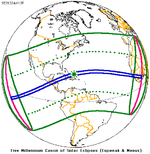 June 13, 2132 |
 June 25, 2150 |
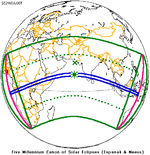 July 5, 2168 |
| 39 | 40 | 41 |
 July 16, 2186 |
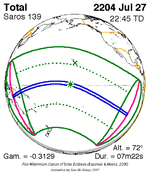 July 27, 2204 |
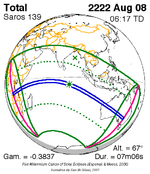 August 8, 2222 |
| 42 | 43 | 44 |
 August 18, 2240 |
 August 29, 2258 |
 September 9, 2276 |
| 45 | ||
 September 20, 2294 | ||
Solar eclipses of 2022–2025edit
This eclipse is a member of a semester series. An eclipse in a semester series of solar eclipses repeats approximately every 177 days and 4 hours (a semester) at alternating nodes of the Moon's orbit.[92]
| Solar eclipse series sets from 2022 to 2025 | ||||||
|---|---|---|---|---|---|---|
| Ascending node | Descending node | |||||
| Saros | Map | Gamma | Saros | Map | Gamma | |
119 Partial from CTIO, Chile |
2022 April 30 Partial |
−1.19008 | 124 Partial from Saratov, Russia |
2022 October 25 Partial |
1.07014 | |
129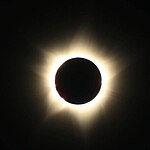 Total from East Timor |
2023 April 20 Hybrid |
−0.39515 | 134 Annular from Campeche, Mexico |
2023 October 14 Annular |
0.37534 | |
139 Total from Indianapolis, USA |
2024 April 8 Total |
0.34314 | 144 | 2024 October 2 Annular |
−0.35087 | |
| 149 | 2025 March 29 Partial |
1.04053 | 154 | 2025 September 21 Partial |
−1.06509 | |
It is also part of a tritos cycle, repeating at alternating nodes every 135 synodic months (≈ 3986.63 days, or 11 years minus 1 month).[93]
Metonic seriesedit
The metonic series repeats eclipses every 19 years (6939.69 days), lasting about 5 cycles. Eclipses occur in nearly the same calendar date. In addition, the octon subseries repeats 1/5 of that or every 3.8 years (1387.94 days). All eclipses in this table occur at the Moon's ascending node.

